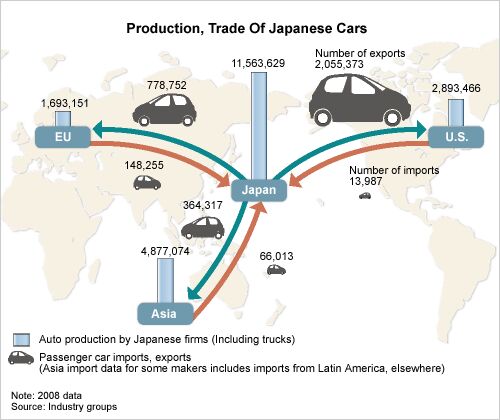Japanese Import Restrictions? Shall We Draw You A Map?

A lot of bandwidth is wasted in the blogosphere about how closed the Japanese car market supposedly is to foreign imports. Which of course is baloney. Paul Niedermeyer debunked the propaganda, and said: “Want to import cars to Japan? It’s one of the easiest countries to do so.“
In case people have not really gotten it, The Nikkei [sub] has drawn them a picture. It painstakingly lists how many cars were made by Japanese manufacturers at home and abroad. It shows how many cars were exported, and how many were imported.
Sure, fewer cars were imported than exported. What do you expect from a country that manufactured more than 11m cars, but bought only 5m at home? (All data 2008, exact import & export data not yet available for 2009.) There is a huge disparity between U.S. exports to Japan and Japanese exports to the U.S. Between Europe and Japan, the disparity is there, but it’s not so large at all. Japan to Europe: 779,752 units. Europe to Japan: 148,255 units.
Actually, people in Japan are worried: Europe is changing from displacement taxation to CO2 taxation. Says the Nikkei: “If the European method becomes a global standard, even carmakers with advanced environmental technology — such as Toyota Motor Corp. and Honda Motor Co. — would have to spend a lot on further technological development.”

Bertel Schmitt comes back to journalism after taking a 35 year break in advertising and marketing. He ran and owned advertising agencies in Duesseldorf, Germany, and New York City. Volkswagen A.G. was Bertel's most important corporate account. Schmitt's advertising and marketing career touched many corners of the industry with a special focus on automotive products and services. Since 2004, he lives in Japan and China with his wife <a href="http://www.tomokoandbertel.com"> Tomoko </a>. Bertel Schmitt is a founding board member of the <a href="http://www.offshoresuperseries.com"> Offshore Super Series </a>, an American offshore powerboat racing organization. He is co-owner of the racing team Typhoon.
More by Bertel Schmitt


































Comments
Join the conversation
It's not really trade restrictions, but more of what the market demands. European automakers were more successful in Japan since they limited themselves to luxury and niche cars. They would be mercilessly slaughtered if they sent over their bread-and-butter cars to compete with Toyota and Nissan in Japan. This is what Hyundai found out recently when they decided to stop selling cars in Japan. The Japanese are successful in the U.S. is they designed their U.S.-market cars for American tastes (e.g. American-market Accords and Camrys). The successful Europeans (Germans and Swedes) targeted the appropriate luxury car niches. This is one thing British Leyland, Peugeot, and Fiat never quite figured out.
I don't mean to sidetrack the discussion, but I was wondering if anyone knows the regulations for importing an *old* car into Japan. I'm intending to move to Fukuoka in two years, and I'd love to bring my r.h.d. '66 MGB-GT along. I've heard there's something called a "model approval fee" which is something in the neighborhood of ¥200,000, and who knows what other kinds of hoops one has to jump through. Can anyone shed light on this?
Too funny. Let's get some facts out of the way: 1. Ford and GM cars are competitive with Japanese cars everywhere in the world, but Japan. 2. Ford and GM sell left and right drive cars all over the world. 3. Ford and GM sell cars in Europe which has similar driving conditions to Japan. 4. Prices charged on imports in Japan are 75-100% of the same price in the home market.
This article is does not tell the entire story of why American or European imports make up such a small percentage of the Japanese and Korean home markets. Just read a few sentence below and then check the other article as see “What the truth about cars” is Steve Biegun, a strategist for Ford, during a lecture in 2007 stated this about Ford’s attempts to break into the Korean car market * Ford was barred from airing advertising commercials except between 2 a.m. and 6 a.m. * Its showrooms’ floor space was restricted by government regulation. * Korean tax officials automatically audited anyone who bought a foreign car The tax audit tactic was copied from the Japanese. The Japanese also adjusted emission requirements, as needed, to block entry of foreign car makers, changing the requirements, while shipments of cars were in transit, so that they would not meet emissions specific ions upon arrival. What cars are allowed in are the more expensive luxury ones, the cars that don’t compete against the cars of the masses. Example Korea: The #1 selling car in Korea for 2011 was the Mercedes E300 CDi at just over 7,000 sold in a market of 1,484,082 cars sold or in other words a ratio of 7:1484 and that is the largest selling imported car, the rest have numbers even smaller than that. What about a total of 275,000 imported vehicles into Japan in a market of over 4,210,0000 vehicles? 275,000 vehicles divided up between 52 importers of which a few are Japanese nameplates. What about the closed parts industry in Japan, while there maybe a bias against foreign cars, a light bulb is a light bulb, a wiper blade is a wiper blade, show me a foreign parts suppliers not tied to a Japanese car maker that sells in Japan. Publish this list and the % sales in Japan. If you doubt what I type go to this web site, you will be stunned. http://counterpunch.org/2009/07/03/detroit-s-collapse-the-untold-story/